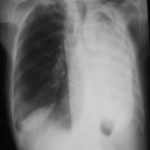Date: 26 November 2013
Secondary metabolites, 3D structure: Trivial name – citreoviridin
Copyright: n/a
Notes:
Species: A. terreusSystematic name: D-Iditol, 2,5-anhydro-1,6-dideoxy-2-C-[(1E,3E,5E,7E)-8-(4-methoxy-5-methyl-2-oxo-2H-pyran-6-yl)-2-methyl-1,3,5,7-octatetraenyl]-4-C-methyl- (9CI)Molecular formulae: C23H30O6Molecular weight: 402.481Chemical abstracts number: 25425-12-1Selected references: Franck B, Gehrken HP. Angew Chem Int Ed Engl. 1980;19(6):461-2 Citreoviridins from Aspergillus terreus.Toxicity: Citreoviridin is produced by P. citreonigrum (synonyms P. citreoviride and P. toxicarium), particularly in rice after harvest. It can cause cardiac beriberi in man. Acute cardiac beriberi in Japan is now only of historical interest although P. citreonigrum and citreoviridin are still reported in other parts of Asia. The fungus is said to be favoured by the lower temperatures and shorter hours of daylight occurring in the more temperate rice growing areas. The toxin is also produced by P. ochrosalmoneum. Citreoviridin has been found in un-harvested corn in the USA. Citreoviridin is an unusual molecule consisting of a lactone ring conjugated to a furan ring, with a molecular weight of 402. It is a neurotoxin. Nishie K, Cole RJ, Dorner JW. Res Commun Chem Pathol Pharmacol. 1988 Jan;59(1):31-52.Toxicity of citreoviridin.
Images library
-
Title
Legend
-
Pt AR Interval development of chronic cavitary pulmonary aspergillosis in the context of sarcoidosis
This patient was diagnosed with sarcoid after developing a chronic cough with the attached chest X-ray. In February 2003 the X-ray demonstrated bilateral extensive changes consistent with fibrocystic sarcoidosis with a complex cavitary area in both apices, more marked on the right. She was given a course of corticosteroids.
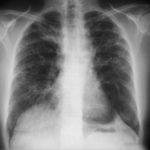
-
Further details
Image B. Additional cavities are apparent inferior to this large cavity and are in communication both with the bronchi and the additional cavities. Some of the apparent cavities are probably dilated bronchi. The left lower lung is completely opacified otherwise. The degree of pleural fibrosis surrounding the left apical cavity is reduced slightly over the interval of four months.
Image C. This shows an almost normal hyperexpanded right lung with a very substantially contracted left lung with one large airway visible and probably incontinuity with a slightly irregular cavity containing some debris, presumably fungal tissue. Other levels show very large left apical cavity with numerous subsections containing debris or fibrotic tissue and almost complete fibrosis of the lung below the level of the carina on the left, with some calcification within the fibrotic lung tissue.
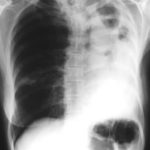 ,
,  ,
, 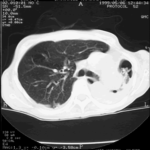
-
Transverse sections through the thorax of a patient with AIDS, hepatitis C and a left tempero-parietal cerebral lymphoma. His CD4 cell count was 45 x 106 / l. The lymphoma was proven by biopsy after a poor response to anti-toxoplasma therapy. He was given dexamethasone to cover the surgery and then developed diabetes mellitus. He did not receive chemotherapy for his lymphoma but did have 2 cerebral radiotherapy treatments (1.8 Gy each). Three weeks after the biopsy he developed dyspnoea and fever. Shortly after this he developed a right-sided hemiparesis, became comatose and died 2 days later.Autopsy showed a cerebral lymphoma and pulmonary and renal aspergillosis. Aspergillus nidulans was recovered from cultures of lungs and kidney.
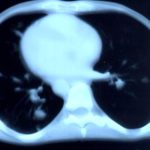 ,
, 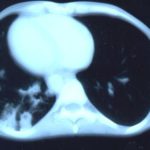 ,
,  ,
, 
-
Fever chart of Pt CA -heart transplant pt with candidemia on amphotericin therapy, who developed pulmonary aspergillosis.

-
A Colonies on MEA + 20% sucrose after two weeks; B ascomata, x 40; C conidia and conidiophore, x 920; D ascospores and conidia x2330; E portion of ascoma with asci x920

-
A 66 yr old patient in good general health developed onychomycosis. Samples taken from the affected nail were grown by culture and examined by microscopy. Oral itraconazole pulse therapy was given to the patient (200 mg twice daily for 1 week, with 3 weeks off between successive pulses, for four pulses) and treatment was successful.
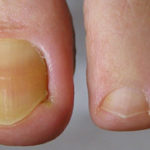

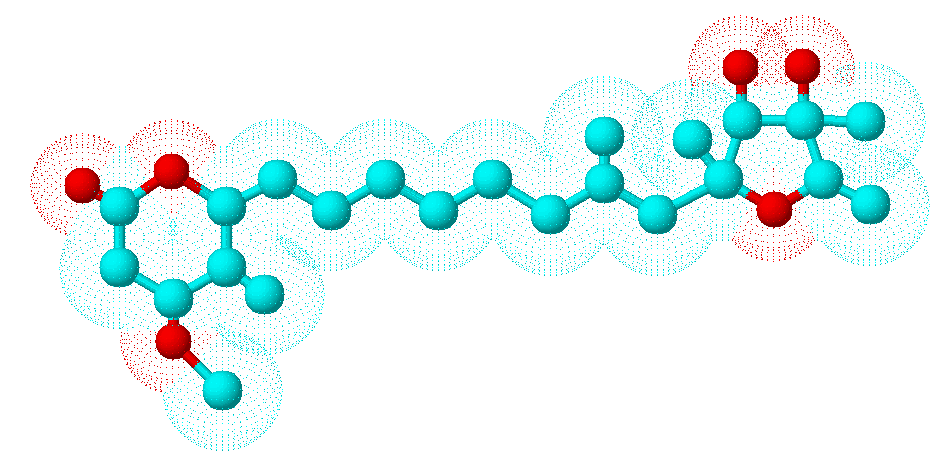

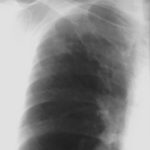 ,
,  ,
, 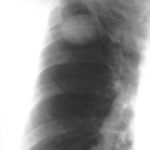 ,
, 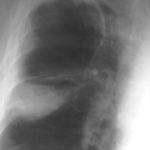 ,
,  ,
, 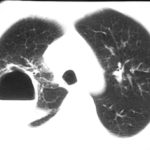
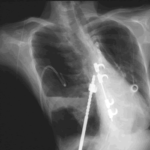
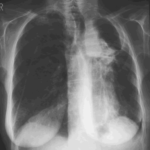 ,
, 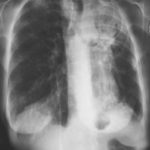 ,
, 